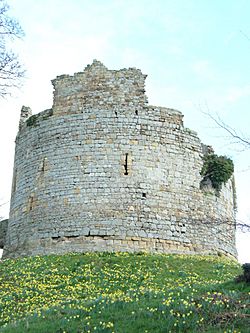Hawarden Castle (medieval) facts for kids
Quick facts for kids Hawarden Castle |
|
|---|---|
| Part of Flintshire | |
| Hawarden, Wales | |

A view of the keep
|
|
| Type | Medieval castle |
| Site information | |
| Condition | Ruin |
| Site history | |
| Built | late 13th century |
| Built by | Attributed to Marcher Lords |
| Events | Welsh Wars |
| Garrison information | |
| Past commanders |
Roger de Clifford |
|
Listed Building – Grade I
|
|
Hawarden Old Castle (Welsh: Castell Penarlâg) is an old medieval castle. It is a Grade I listed building. You can find it near Hawarden, in Flintshire, Wales.
This castle is now a ruin. It stands on the estate of the newer Hawarden Castle. Sometimes, you can visit the ruins. They are usually open on the second and fourth Sundays during the summer.
Contents
The Castle's History
The exact beginnings of Hawarden Old Castle are not fully known. Some people think the very first defenses here were built during the Iron Age. Later, it might have been a Norman Motte-and-bailey castle. This type of castle had a mound (motte) and a walled yard (bailey).
A Key Role in Welsh History
Hawarden Castle was very important during the 13th century. This was a time when the Welsh people were fighting for their independence. They wanted to be free from Norman England.
In 1282, a Welsh leader named Dafydd ap Gruffydd attacked Hawarden Castle. This attack happened on Easter Sunday. It marked the start of the final big conflict between Wales and England. Sadly, after this war, Wales lost its independence.
King Edward I of England was very angry about Dafydd's attack. He ordered a very harsh punishment for Dafydd. Dafydd was executed in Shrewsbury in October 1283.
Later Conflicts
The castle was attacked again in 1294. This happened during a revolt led by Madog ap Llywelyn.
After the English Civil War
In the 17th century, England had a big conflict called the English Civil War. After this war, Oliver Cromwell ordered that Hawarden Castle be "slighted." This means parts of the castle were deliberately destroyed. This was done to make sure it could not be used as a military stronghold again.

